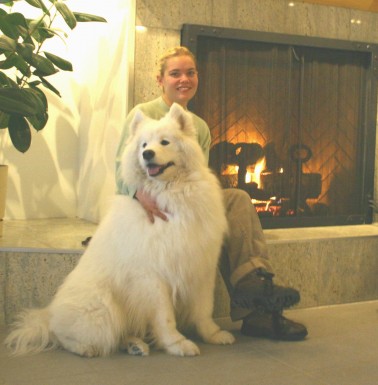Q. My dog does not want to enter her new travel crate. Can you help me?
Q: My dog has to be relocated from Montreal to SAO PAULO, Bresil. We came to Manoir Kanisha and we purchased an excellent travel crate. It was quite easy to assemble. Now, we are facing a real problem. Our Rottweiler TINA refuses to go into her travel crate. We are surprised of this situation. She always slept into her wire mesh crate. How do we get her used to her travel crate. She has to travel in 3 weeks and we are very worried that she will not want to enter the travel crate. Can you help me?
Answer: Here are few suggestions:
1…Light:A travel crate is less lit than a wire crate. I suggest that you place the travel crate close to a light so the inside is less dark.
2..Meals: If the inside or the crate is very well light and Tina still refuses to enter, try placing her food inside the crate, first close to the door and gradually pushing the bowl towards the far end of the crate floor.
3…Personal Items: If the two above suggestions do not work, place her cushion inside the crate, her toys…
4…Disassemble the crate: You can also disassemble the crate and place ONLY the bottom at the same place as her usual sleeping area. Place her cushion in it. Gradually, place the top but no door. Remember to keep the inside with good lighting.
5… Food and water: Only feed her inside the crate, only place her water inside the crate.
6…As she gradually goes in, you can add the door but keep it always open. Then sit beside the crate and close the door for a few minutes. open it and give her a treat. Let Tina gradually understand that the crate is her special place and she will get rewarded if she goes in.
7… After her exercise: Place her in the crate after her running. She will be more relaxed and fall asleep.
8…Duration of her crate period: As she accept the period in the crate, make them gradually longuer. Place the crate in your sleeping room. Eventually she should spend al night in her crate sleeping beside you.
9… Moving crate: Finally, ^place the crate in your car or mini van and dride around with Tina in it. She will get used to relaxing as the crate moves and become totally comfortable.
I hope the above will be useful and successful.
Nicole
—————————————————————–
Q: What is the difference between ‘accompanied baggage’ and ‘excess baggage’?
Answer: Essentially they are the same. Some airlines may accept pets on certain routes as ‘excess baggage’ but this can only be established by the passenger at the time of booking their seat. It depends on several factors that only the passenger can determine, such as the status of the ticket, what the pet may be ‘in excess of’, the policy of the airline, the particular route, and the regulations of the importing country. But it is important to understand that the term ‘accompanied baggage’ does not mean that the pet may travel in the passenger cabin. This, again, depends on the policy of the airline, the particular route, the type of aircraft, and whether the container can fit under the seat in front of you. This seldom exceeds 9inches in height, and is usually only accepted on internal, not international, flights.
Q. How do I measure my dog for the selection of the correct air travel crate?
Answer: It is almost impossible to measure a dog directly. Much easier to hold against a wall like a small child and mark the height and length. These are the two measurements we need.
Q. Why is measurement more important than weight?
Answer:
Knowing the weight is important, but the dimensions of the pet decide the size of the flight container. It is the size of the container that decides the freight costs, much more than the mere weight. Old question: Which is heavier? A pound of feathers or a pound of lead? Obviously they are the same weight, but the feathers occupy so much more space that they will be charged at a higher rate. The same goes for pets because they have a lot of comfort space around them.
Q: Why is the air transport of my small pet so much more expensive than my own air ticket?
Answer: The cost of cargo has no relationship whatsoever to the cost of a passenger seat. All passenger seats are the same size, so there is not much variation on seat costs. But there is an enormous variation in cargo costs based primarily on the volume of the container (rather than the weight), the availability of space, and the type of aircraft. Live animals are charged at least 150% higher than other freight simply because of the extra care and handling required.
Q. Why can I not take my pet into the aircraft cabin?
Answer. Some carriers might allow pets in the cabin, but only if they can fit under the seat in front of you. This can only be achieved with soft sided carriers, which are not permitted for international travel. All pets must be transported in rigid containers for security reasons. Furthermore, the airline does not know if the passengers around you may be allergic to pets or the animal may begin to smell during flight.
Q. What is it like for my pet in the cargo compartment?
Answer: The cargo compartment for pets is heated, pressurised, ventilated and lit exactly as your own passenger compartment. Pets, like you, quite sensibly, go to sleep.
Q. Should I tranquilise my pet in flight?
Answer: No. All sedatives reduce blood pressure. Have you ever climbed over 10,000 feet up a mountain? Pets react in the same way. It is important never to give any tranquiliser to a pet in flight. This reduces blood pressure. Since the aircraft is already pressurized to 8,000 ft (whatever height they fly at) which is the highest a body can usually accept in comfort, any tranquilisers further reduce blood pressure giving the effect of rising above 10,000 ft, thus inducing altitude sickness. The pet then loses balance, motor control, temperature regulation, regularity of breathing etc, just as in humans. In extreme cases, especially with brachycephalic breeds, this can lead to death. This is therefore contra-indicated by all veterinary authorities.
The very best strategy for your pet is to make him comfortable with the flight kennel. This may involve up to three weeks training, which starts with feeding and sleeping in it, and building up to closing him in for the night. Thus the pet comes to understand that they will be released, that it is not a punishment, and all will be calm on the day of departure.



